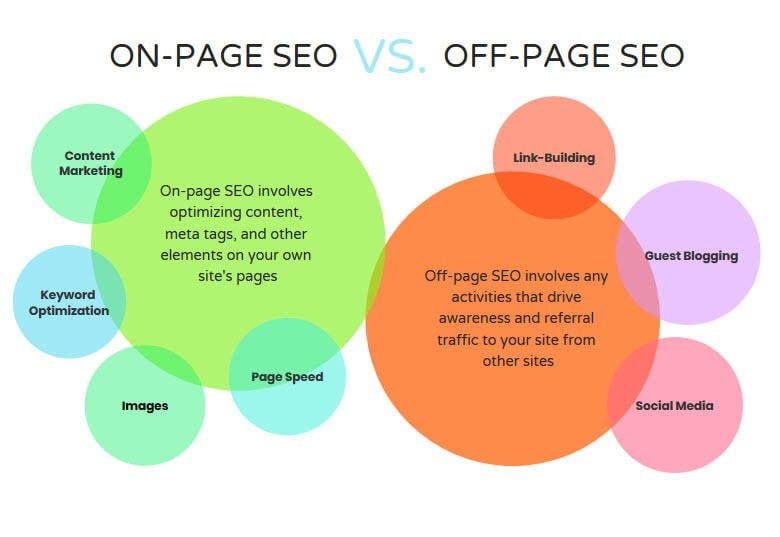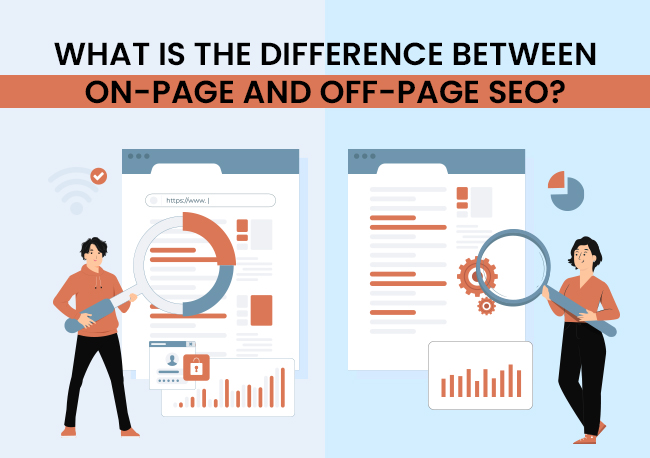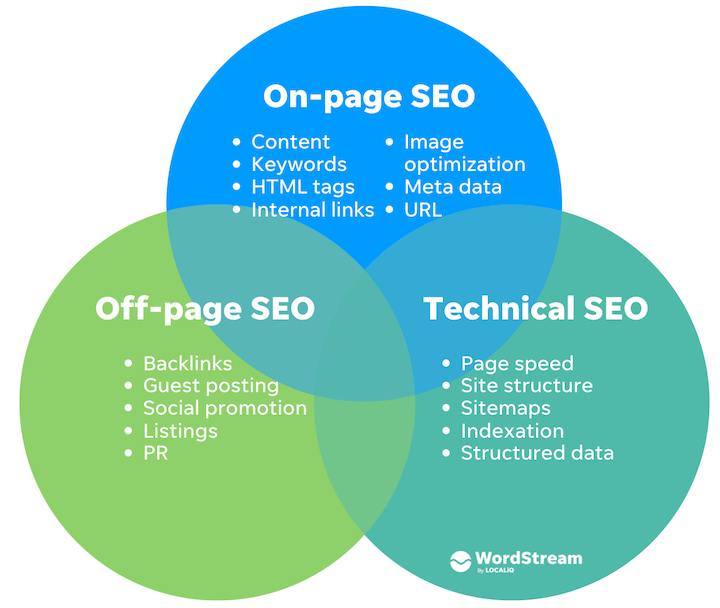Unravel the mystery of SEO strategies! Learn the crucial differences between on-site and off-site SEO for maximum impact online.

Image courtesy of via DALL-E 3
Table of Contents
Introduction to SEO
SEO, or Search Engine Optimization, is like a secret code that websites use to communicate with search engines. Just like how you use keywords to search for things online, websites use SEO to speak the language of search engines and get noticed. It’s a powerful tool that helps websites stand out in the crowded online world.
What is SEO?
SEO is all about making sure that search engines like Google, Bing, and Yahoo can easily find and understand your website. Imagine if your favorite toy was hidden in a messy room – you wouldn’t be able to find it! SEO helps organize websites so that search engines can quickly locate and show them to people searching for information.
Importance of SEO
SEO is crucial for websites because it acts like a bright neon sign in a sea of websites. When a website has good SEO, it becomes more visible to people searching on the internet. This increased visibility means more people can find and visit the website, leading to more traffic and potential success for the website owner.
Understanding On-Site SEO
Search Engine Optimization (SEO) plays a crucial role in helping websites get noticed on the internet. Within the realm of SEO, there are two main categories: On-Site SEO and Off-Site SEO. In this section, we will delve into what On-Site SEO entails and how it benefits websites.
What is On-Site SEO?
On-Site SEO, also known as on-page SEO, involves optimizing various elements on a website to improve its search engine rankings and visibility. This optimization focuses on factors that webmasters have control over, such as the content, structure, and HTML of the site.
Key On-Site SEO Factors
Effective On-Site SEO relies on several key factors to enhance a website’s performance in search engine results. Here are some essential elements to focus on:
- Keywords: Integrating relevant keywords throughout your website’s content is crucial for search engines to understand what your site is about and rank it accordingly.
- Meta Tags: These include meta titles and meta descriptions that provide search engines and users with an overview of your webpage’s content.
- Internal Links: Connecting various pages within your website through internal links helps search engines navigate and index your site more effectively.
By optimizing these factors and paying attention to the details, webmasters can improve their website’s visibility and attract more organic traffic.
Understanding Off-Site SEO
Off-Site SEO refers to the efforts and activities conducted outside of a website to improve its search engine rankings. While On-Site SEO focuses on optimizing elements within the website itself, Off-Site SEO focuses on building authority and credibility through external factors.

Image courtesy of www.wordstream.com via Google Images
Key Off-Site SEO Factors
One of the most crucial factors in Off-Site SEO is backlinks. Backlinks are links from other websites that direct traffic to your site. Search engines consider backlinks as a vote of confidence in the quality of your content. The more high-quality backlinks you have, the more authority your site gains.
Social media signals also play a significant role in Off-Site SEO. When your content is shared, liked, or commented on through social media platforms, it indicates to search engines that your content is valuable and engaging. This social proof can boost your site’s ranking in search results.
Benefits of On-Site SEO
On-Site SEO plays a crucial role in helping websites climb higher on search engine result pages. By optimizing content with relevant keywords and ensuring proper meta tags and descriptions, search engines can better understand what your website is about. This, in turn, increases the likelihood of your site appearing at the top when users search for related topics.
Enhanced User Experience
Aside from boosting your search engine ranking, On-Site SEO also focuses on enhancing the overall user experience of your website. By organizing content in a user-friendly manner, improving site navigation, and ensuring fast loading times, visitors are more likely to stay longer on your site, explore different pages, and ultimately convert into customers or subscribers.
Benefits of Off-Site SEO
One major benefit of focusing on Off-Site SEO is that it can help build credibility for your website. When other reputable sites link back to your content, it signals to search engines that your site is trustworthy and authoritative. This can result in higher rankings in search engine results pages, making it easier for potential visitors to find your website.

Image courtesy of www.hostitsmart.com via Google Images
Boosts Website Traffic
Off-Site SEO also plays a crucial role in driving more traffic to your website. By obtaining backlinks from other sites and engaging in social media activities, you can increase your online visibility and attract a larger audience. When users see links to your content on different platforms, they are more likely to click through and visit your site, leading to a steady flow of organic traffic.
Comparing On-Site and Off-Site SEO
When it comes to optimizing your website for search engines, there are two main strategies you need to consider: On-Site SEO and Off-Site SEO. Both play crucial roles in improving your website’s visibility and traffic. Let’s take a closer look at how these two approaches differ and how they can work together to boost your site’s performance.
Key Differences
On-Site SEO focuses on optimizing the content and elements present on your website itself. This includes using relevant keywords in your content, creating descriptive meta tags, and incorporating internal links to improve navigation. On the other hand, Off-Site SEO involves activities that take place outside of your website, such as building backlinks from reputable sources and engaging with your audience on social media platforms.
How They Work Together
While On-Site SEO and Off-Site SEO may seem like separate strategies, they actually complement each other in achieving the best results for your website. On-Site SEO lays the foundation by making your website more search engine-friendly, while Off-Site SEO helps to build credibility and drive more traffic to your site through external links and social media shares.
Common On-Site SEO Techniques
One of the most crucial aspects of On-Site SEO is keyword optimization. This simply means using relevant keywords strategically throughout your website content. When someone searches for a specific term on a search engine, having those keywords on your site increases the chances of your website showing up in the search results. So, make sure to research and use the right keywords that are relevant to your content.

Image courtesy of www.logique.co.id via Google Images
Meta Tags and Descriptions
Meta tags and descriptions play a vital role in On-Site SEO. These are the hidden snippets of text that provide information about your website to search engines. When someone searches for a particular topic related to your site, these meta tags and descriptions help search engines understand what your website is about. So, make sure to create unique and compelling meta tags and descriptions for each page on your website to improve your SEO performance.
Common Off-Site SEO Techniques
One of the most crucial techniques in Off-Site SEO is building backlinks. Backlinks are links from other websites that direct users back to your site. Having high-quality backlinks from reputable sites can significantly improve your website’s authority and credibility in the eyes of search engines like Google. The more backlinks you have from trustworthy websites, the more likely your site will rank higher in search engine results.
Social Media Engagement
Social media engagement is another effective Off-Site SEO technique. By actively participating in social media platforms like Facebook, Twitter, and Instagram, you can increase your website’s visibility and reach a broader audience. Sharing your content on social media, engaging with followers, and encouraging them to share your posts can generate more traffic to your site. Additionally, social signals, such as likes, shares, and comments, can also positively impact your website’s search engine rankings.
Conclusion
In this blog post, we’ve delved into the world of SEO, which stands for Search Engine Optimization. We learned that SEO is crucial for websites as it helps search engines find and rank them based on specific criteria.

Image courtesy of www.wordstream.com via Google Images
On-Site SEO focuses on optimizing the content and elements within a website, including the use of relevant keywords, meta tags, and internal links. This helps improve the website’s visibility and user experience.
On the other hand, Off-Site SEO involves activities outside the website, such as building backlinks and engaging on social media platforms. These external efforts help boost credibility and drive more traffic to the website.
Final Thoughts
It’s essential to understand that both On-Site and Off-Site SEO play crucial roles in enhancing a website’s visibility and performance. While On-Site SEO focuses on optimizing the website itself, Off-Site SEO works on building authority and trust through external means.
For the best results, it’s important to strike a balance between On-Site and Off-Site SEO practices. By implementing both strategies effectively, website owners can improve their rankings, boost traffic, and enhance the overall user experience.
Want to turn these SEO insights into real results? Seorocket is an all-in-one AI SEO solution that uses the power of AI to analyze your competition and craft high-ranking content.
Seorocket offers a suite of powerful tools, including a Keyword Researcher to find the most profitable keywords, an AI Writer to generate unique and Google-friendly content, and an Automatic Publisher to schedule and publish your content directly to your website. Plus, you’ll get real-time performance tracking so you can see exactly what’s working and make adjustments as needed.
Stop just reading about SEO – take action with Seorocket and skyrocket your search rankings today. Sign up for a free trial and see the difference Seorocket can make for your website!
FAQs
Why is On-Site SEO important?
On-Site SEO is crucial because it helps search engines understand what your website is about. By optimizing your content and structure, you make it easier for search engines to index your site and show it in relevant search results.
How can I improve my Off-Site SEO?
Improving your Off-Site SEO involves activities outside your website that can boost your rankings. One effective strategy is to focus on acquiring high-quality backlinks from reputable websites. Engaging with social media platforms and sharing your content can also help increase your online presence and drive more traffic to your site.







